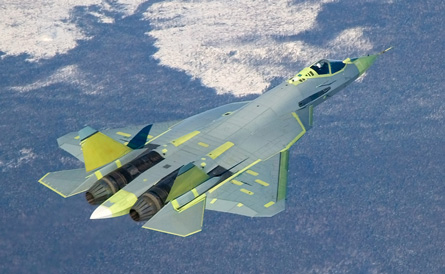If the number of aircraft projects on the go in Russia's aerospace sector is any benchmark then it appears to be growing in confidence. The Antonov An-148 regional jetliner has recently entered service, the delayed Sukhoi Superjet should be in the hands of customer airlines by the end of the year and, in the medium term, the MS-21 medium-size jet is planned to be a genuine contender in the 150- to 210-seat class.
Similarly in the military field, the fifth-generation PAK-FA fighter is edging closer to service and if Russian plans for taking the type on strength are matched by the Indian air force, it could be a serious rival to the Lockheed Martin F-22 Raptor - not to mention having a bigger production run than the US aircraft.
Russia appears also to harbour real hopes for success in the advanced trainer sector with the Yakovlev Yak-130, which was initially a joint Russo-Italian project before Aermacchi went its own way with its M-346 Master.
 |
|---|
© SukhoiRussia's fifth-generation PAK-FA fighter is edging closer to service |
Russia is due to finalise a major rearmament programme later this year and this could lead to the reopening of the production line for the Antonov An-124 heavylift transport (Antonov is, of course, a Ukrainian company but retains strong links with the Russian aerospace industry) and orders for the Ilyushin Il-476, a major modernisation of the rugged Il-76 freighter.
For RSK MiG, probably the most venerable name in Russian military aviation, much depends on whether it wins the Indian air force's Medium Multi-Role Combat Aircraft competition for 126 aircraft.
Along with the increasing self-confidence Russia is demonstrating on the world stage has come a move towards re-establishing stronger centralised control over its aerospace assets that had lost cohesion in the 1990s. While nobody talks of recreating the system of government-directed design bureaux and production plants that marked the Soviet era, it is not difficult to see the determination among its leaders to focus its aerospace efforts and create a genuine force in world markets - both civil and military.
That process is marked by a new realism and pragmatism that was perhaps not present - or at least, not readily visible from the West - during the pre-perestroika age.
There is no doubt that Russia's United Aircraft (UAC), the instrument devised to channel and co-ordinate much of the nation's aviation assets, has big ambitions. "In the last year we've completed the process of integrating UAC," chairman Alexey Fedorov says. "The process has focused on absorbing all the assets of the enterprises that produce fixed-wing aircraft.
"In other words, over the past year we were collecting stones that had been thrown before. Starting this year, we actually started the process of building up special integrated structures that specialise in different areas."
He reiterates previous comments that the current 100,000-strong workforce will be gradually cut by about half by 2025, with increased use of new technologies such as computer-aided design and lean working practices helping each worker to be up to 10 times more productive in 15 years' time. Work has already begun on what he admits is a "massive" programme of renovating UAC's production facilities.
Perhaps significantly from the social responsibility point of view, despite the 50% drop in the planned workforce, none of UAC's existing plants is planned to close. However, individual plants will become increasingly specialised in their roles, taking responsibility for particular components or subassemblies, he says. And some operations may be outsourced to specialist external companies.
Russia has long been recognised for the quality of its theoretical aerodynamics and structure of its aircraft - theoretical qualities that have had striking practical applications in aircraft such as the Sukhoi Su-27/30/35 family of fighters - but previous generations of airliners have generally not found many homes outside Russia and its traditional allies. They were built to do a job, rather than have an eye on the bottom line and their operating economics were frequently not in the same class as their Western counterparts.
There seem real hopes that the new generation of airliners will change all that. Western manufacturers such as Pratt & Whitney, Hamilton Sundstrand and Rockwell Collins have been brought in to supply, or at least co-operate on, major items of equipment and provide some reassurance to Western carriers intrigued by, but perhaps still nervous of, buying Russian equipment.
Senior Russian aerospace figures are frank in accepting that a major stumbling block in the past has been after-sales service. They know that they must do better and moves are under way to radically overhaul the speed with which spare parts can be cleared through Russia's export control and customs bureaucracies, for example.
Again, they hope to enlist the help of Western organisations. Irkut has been trying to persuade Lufthansa Technik to support the future MS-21 in service, for example, but only time will tell if these efforts - and they are strenuous efforts - pay off.
Irkut's president, Oleg Demchenko, knows that improving after-sales support is essential: "This is a very big job for us," he admits, "and this is where we have started to focus our efforts." Indeed, he acknowledges that even Russian carriers will have to be won round, noting that 70% of Aeroflot's fleet is comprised of Airbuses.
After the disastrous 1990s in which investment in civil aviation was strangled, the arrival in 2000 of President Putin and his declaration that a civil aviation industry was important for Russia began to turn the industry around. Today, says Demchenko, "This is a national goal for the Russian state." Whether that goal is fulfilled remains to be seen.
Source: Flight Daily News
















